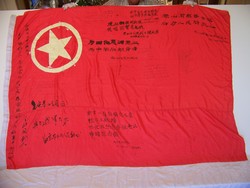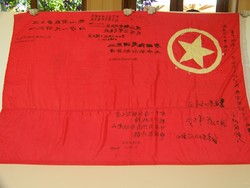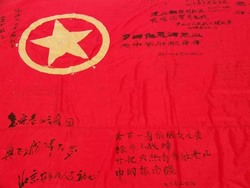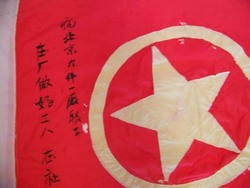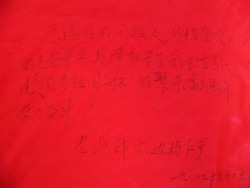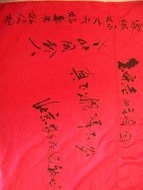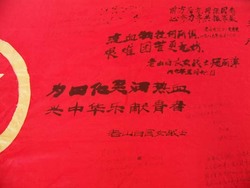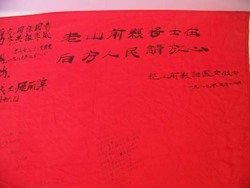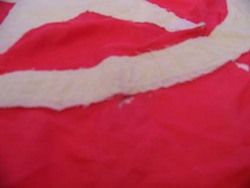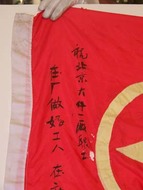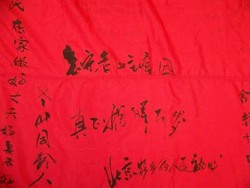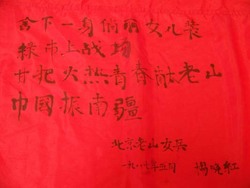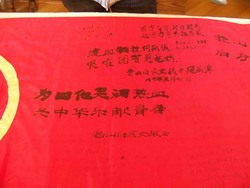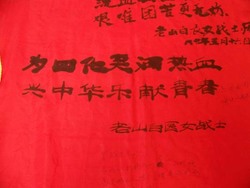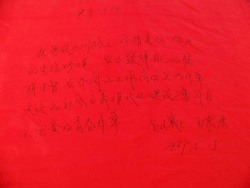Communist Youth League Flag from the Sino-Vietnamese Conflict 1987
This is a presentation flag of the Communist Youth League of China (CYL). The CYL is a youth movement of the People's Republic of China for youth between the ages of fourteen and twenty-eight, run by the Communist Party of China (CPC). The league is organized on the party pattern and functions as an all-purpose school for party youth who are indoctrinated, trained, and prepared to serve as future party regulars. Its leader is identified as its First Secretary and member of the party's Central Committee.
The basic tasks of the CYLC are to adhere to the implementation of the CPCs basic lines and policies of the primary stage of socialism - to unite and lead young people to focus on economic construction; to persist in reform, opening up, self-reliance and hard struggle; to strive to promote productivity and social progress; to build socialism with Chinese characteristics, and to infuse successors with lofty ideals, morals, cultural attainment and discipline; and to train new blood for the CPC and young talents in the building of the country and to persist in the Four Cardinal Principles:
1. the principle of upholding the socialist path;
2. the principle of upholding the people's democratic dictatorship;
3. the principle of upholding the leadership of the Communist Party of China; and
4. the principle of upholding Marxist-Leninist-Mao Zedong thought.
The Communist Youth League was responsible also for guiding the activities of the Young Pioneers, children below the age of fourteen.
On 15 May 1987 soldiers and medical personnel of the Chinese frontier troops guarding Laoshan, Yunnan Province along the Sino-Vietnamese border inscribed and presented this flag to well wishers visiting from Beijing. The Laoshan area has been a site of constant tensions since the Sino-Vietnamese War of 1979.
The Sino-Vietnamese War or Third Indochina War was a brief but bloody border war fought in 1979 between the People's Republic of China (PRC) and the Socialist Republic of Vietnam. The PRC launched the offensive largely in response to Vietnam's invasion and subsequent occupation of Cambodia, a war which ended the reign of PRC-backed Pol Pot's Khmer Rouge. After a brief incursion into northern Vietnam, PRC troops withdrew about a month later. Both sides claimed victory.
This flag is inscribed with sentiments and signatures in at least 14 different places. For the purpose of translation these inscriptions have been numbered.
They are:
1. To the staff of Beijing #1 Plant of Big Machine Parts: We wish you to be outstanding employees at work, good citizens in society, and considerate spouses at home. From your peers on guard at Laoshan.
2. From the regiment guarding the main peak at Laoshan, Long live the genuine mutual understanding! Please put you mind at ease, dear fellow Beijingers.
3. I wish my peers from afar to treasure your precious youthful years and prize your serene and stable living environment. Lets join hands in striving to build up a powerful and prosperous China our Motherland! Bianma Renvheng. Fighter at Laoshan May 15, 1987.
4. Removing our female attire cute and pretty, We, clad in green, stride proudly to battle grounds: Devoting our vibrant youth to Laoshan content and ready, We women vow to keep the south border safe and sound. Yang Xiaohong. Female Soldier at Laoshan.
5. I wish my peers in the heartland to treasure your time, work in earnest, and dedicate your beat years of life to serving the people and our motherland. Li Honghong, Soldier at Laoshan May 15, 1987.
6. To realize the four goals of modernization, I wont grudge giving up every drop of my blood: To rejuvenate China my homeland precious and dear, I cant wait to contribute my lifes best years. Female medic personnel at Laoshan.
7. No bleeding or death do I ever care, Never will hardships make me scare. Pang Liping, Female medic at Laoshan.
8. Once Commanders and fighters stand at the Laoshan front, Compatriots in the rear shall enjoy their peace of mind. Female medic at Laoshan front line, May 16, 1987.
9. Hello, dear peers, I wish my young friends in rear areas, who are basking in a peaceful environment in the era of reforming, to treasure your precious time in your golden years of youth, and contribute all your talents and enthusiasm to the reconstruction of our motherland. Wang Guoming, Fighter at Laoshan 05/15/87
10. Whether on front lines or in the rear, For security of the nation, jointly we fight: With hands joined and minds set, We strive to boost our military might. Jia Xiurong, Female frontier guard May 16, 1987.
11. May this League flag of ours see all of you through the whole period of your enjoyable youth. Li Yuqiang, soldier at Laoshan, May 15, 1987.
12. I wish my peers in the rear areas to prize your enviably stable living environment, try your best to bring your intelligence and wisdom into full play, and on different posts of work dedicate your youthful years to the realization of socialist modernization programs of the Chinese nation. Wang Zhentang, Soldier at Laoshan, May 15, 1987.
13. Dear young friends in the Capital, We hope in earnest that by then time we fade out of the mortal world, historic records will have highlighted the brilliant accomplishments of each and every one of you young people. Fighters at Laoshan.
14. To peers, illegible.
The 1979 war between China and Vietnam would not prove to be the last bloodletting between the two nations, as the conflict escalated again in 1984, 1986 and 1987. While ongoing tensions and skirmishing had up until that point been a constant affair (and although the Sino-Vietnamese border is fairly established) there are still points of contention particularly in the space between border markers that encompass Laoshan (a large hill/mountain formation that straddles the Sino-Vietnamese border).
The debate over territory devolves into a matter of interpretation as to what the mutually recognized border markers represent. The Vietnamese argument is that the border is a straight line between markers irrespective of topographical features. The Chinese counter-argument is that the border between markers should follow the local terrain.
While this may at first glance seem to be a simple issue, the argument does possess geographic value in that depending on interpretation, the high ground terrain falls onto either the Chinese or Vietnamese sides of the border. In 1984, the decision was made for the PLA to evict Vietnamese forces from their heights in order to end the cross-border incursions and shelling of the Chinese side of the border. These skirmishes eventually involved division sized units of both armies. Border incursions continued in 1986 and 1987.
This conflict would not truly end until 1989 when a border settlement and peace treaty was signed to officially end the sporadic fighting leaving Laoshan and hills formerly on the side of the Vietnamese border now under Chinese control.
This flag is a silent witness to history of as conflict almost unknown in the west.
Provenance: The flag was acquired in 2007 in Beijing.
ZFC Significant Flag
Sources:
Communist Youth League of China, China Internet Information Center, 16 November 2011, from:
http://china.org.cn/english/features/state_structure/65010.htm
Communist Youth League of China, Facebook, 16 November 2011, from:
http://www.facebook.com/pages/Communist-Youth-League-of-China/110693812294007
Communist Youth League of China (CYLC), Wikipedia, 16 November 2011, from: http://en.wikipedia.org/wiki/Communist_Youth_League_of_China
Sino-Vietnamese War, Wikipedia, 16 November 2011, from:
http://en.wikipedia.org/wiki/Sino-Vietnamese_War
Image Credits:
Zaricor Flag Collection
